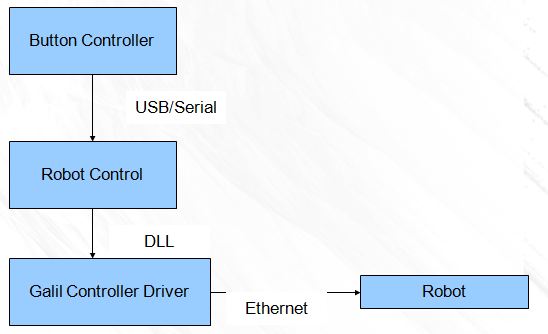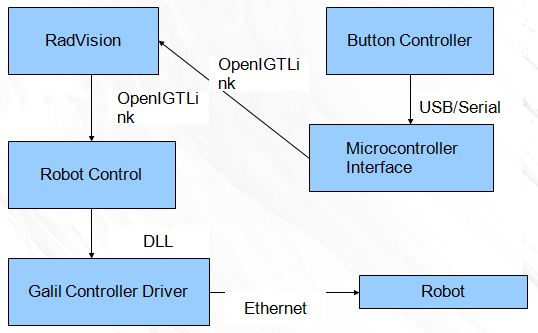Contact Us
CiiS Lab
Johns Hopkins University
112 Hackerman Hall
3400 N. Charles Street
Baltimore, MD 21218
Directions
Lab Director
Russell Taylor
127 Hackerman Hall
rht@jhu.edu
Last updated: 20:00 05/05/2012
The main goal of this project is to integrate the RadVision treatment planning software with the (Trans-Rectal Ultrasound ) or TRUS brachytherapy robot. This integration should allow the surgeon to position the needle of the robot more accurately with the new system. In addition to the integration with RadVision, I intend to participate in an accuracy study in which the accuracy of the TRUS robot in needle placement will be assessed.
The American Cancer Society reports that 240,890 cases of prostate cancer were diagnosed and about 33,720 men will die from it.[1] Prostate Brachytherapy is a minimally invasive radiation therapy that used to treat prostate cancer. The therapy involves the injection of radioactive seeds directly into the prostate near the tumor using fine needles. Unfortunately, attaining the level of accuracy required often takes the surgeon more than one attempt at inserting the needle. Increasing the accuracy of the needle insertion with a robotic system would allow faster surgeons with better results.
The conventional approach uses a grid of holes (template) located over the prostate to position and guide the needle for insertion. The needle itself is monitored in real-time by an ultrasound probe positioned below the prostate. Since the seed insertion must be very accurate and the final location of the end of the needle cannot be predicted, the surgeon often must insert the need multiple times using multiple holes in the grid. The TRUS robot replaces the function of the grid of holes by using two 2-dimensional servo mechanisms to position and guide the needle. The two dimensional grid allows the user to control both the 2 dimensional insertion location as well as the angle of the needle.
In addition to the integration with RadVision, the accuracy study in which I plan to participate will assess the accuracy of the TRUS robot in needle placement. The results of this assessment could be used to compare this robotic system with other robotic systems that are used in the same procedure.
The TRUS robot is a 4 degree of freedom robot. Two degrees of freedom come from each of the two 2-axis Galil servo mechanisms. Each servo mechanism holds one end of a aluminum tube that holds the needle. This setup allows for both 2D needle positioning as well as orientation. The base of the robotic system consists of a pivot that allows the whole system to be manually pivoted. On top of the pivot mechanism lies the ultrasound probe. Since the ultrasound probe is being held at a fixed distance from the servo mechanism the mechanism can be registered to the robot.
The first step in the project is to rebuild the setup for the TRUS robot currently in the robotorium. Since I have chosen to use my laptop as the computer to complete this step I must install all of the necessary drivers and resolve any compatibility issues between my laptop and the TRUS robot. Since my laptop runs Windows 7, and the old Galil drivers were not compatible with windows 7, I was forced to rewrite the CISST wrapper for the new Galil drivers.
The second step in this project is to integrate the software that currently controls the TRUS robot with the RadVision software I should receive from the company (Acoustic MedSystems). The RadVision software will provide the target positions for the robot. It will also receive movement adjustment commands from the button interface of the TRUS robot, and then send the position changes to the software that controls the TRUS robot. Communication between the robot control software and Radvision will be handled by the OpenIGTLink protocol. Communication between the computer and the robot is handed by an Ethernet link.
System before changes
 System after changes
System after changes

The accuracy study has two parts. The first part involves poking graph paper reinforced by Styrofoam with a needle in a specific pattern. A high definition camera is used to take pictures of the needle insertion to measure accuracy. The second part involves inserting dummy radioactive seeds into a phantom jet. The seeds are placed in a pattern. After the insertions the phantom is imaged by a CT machine in order to measure the accuracy of the insertions.
RadVision is fully integrated into the TRUS system. I am now able to control the robot through RadVision. Unfortunately I will not be able to achieve the desired goal of connecting the button controller with RadVision because this functionality was not built into RadVision, and I do not have the source code to make the necessary changes myself.
My progress in this aspect of my project was severely set back when I discovered that the fingers for holding the needle were missing. It took me about 2 weeks to fabricate new ones.
The first phase of the accuracy study is all set up. The whole system as well as the graph paper is ready for testing.
Updated Timeline at Checkpoint
Here give list of other project files (e.g., source code) associated with the project. If these are online give a link to an appropriate external repository or to uploaded media files under this name space.